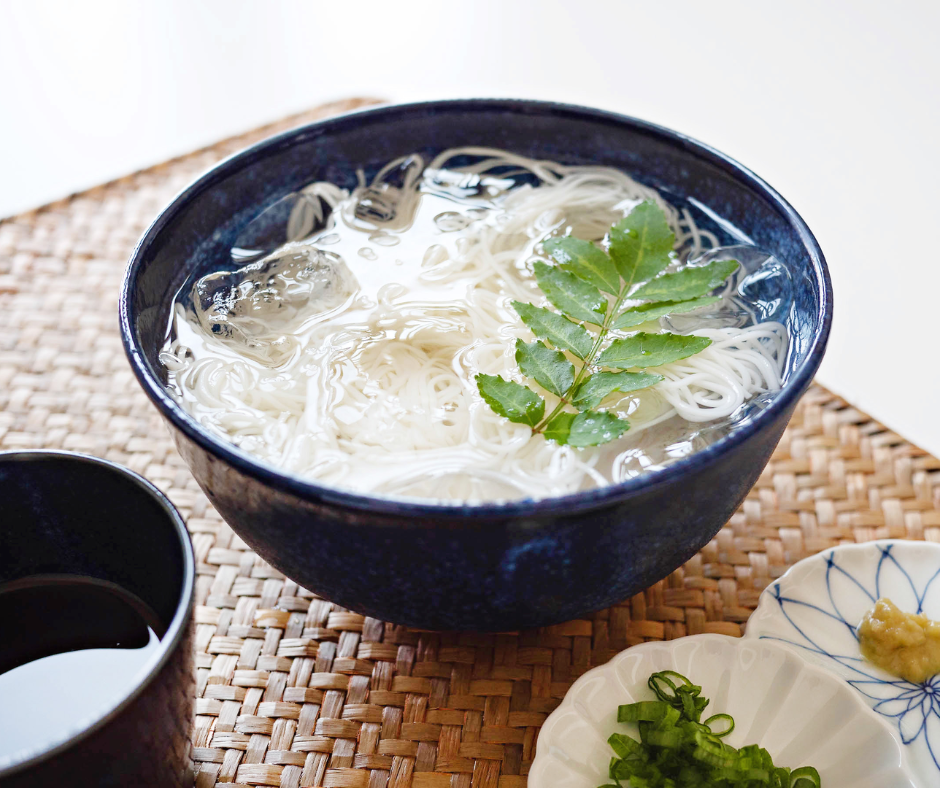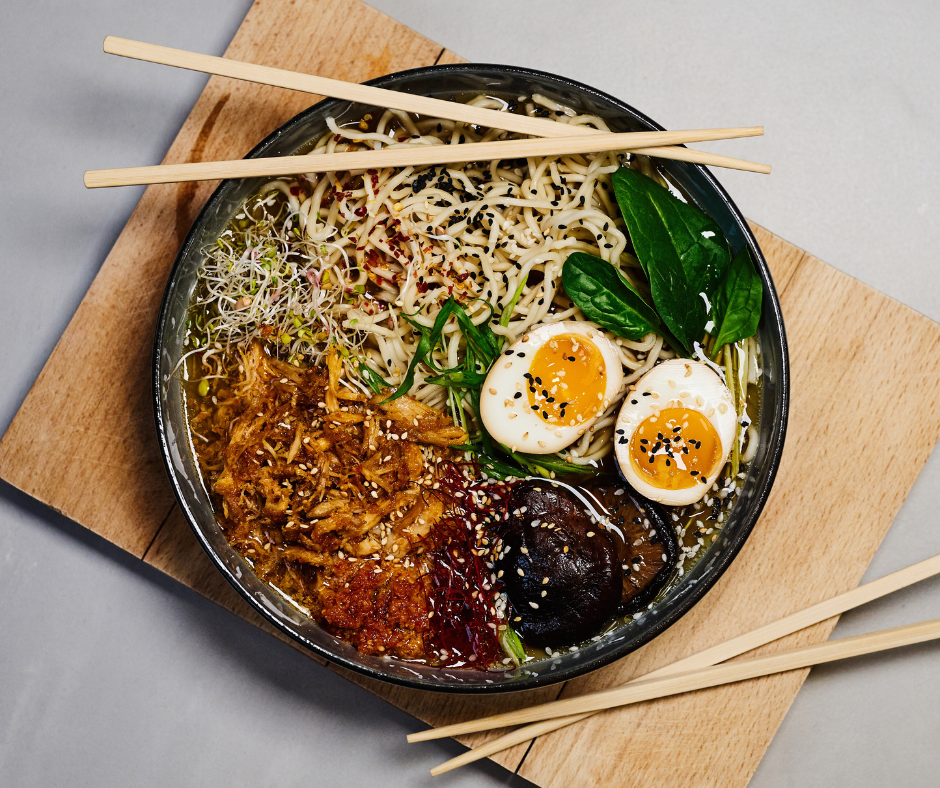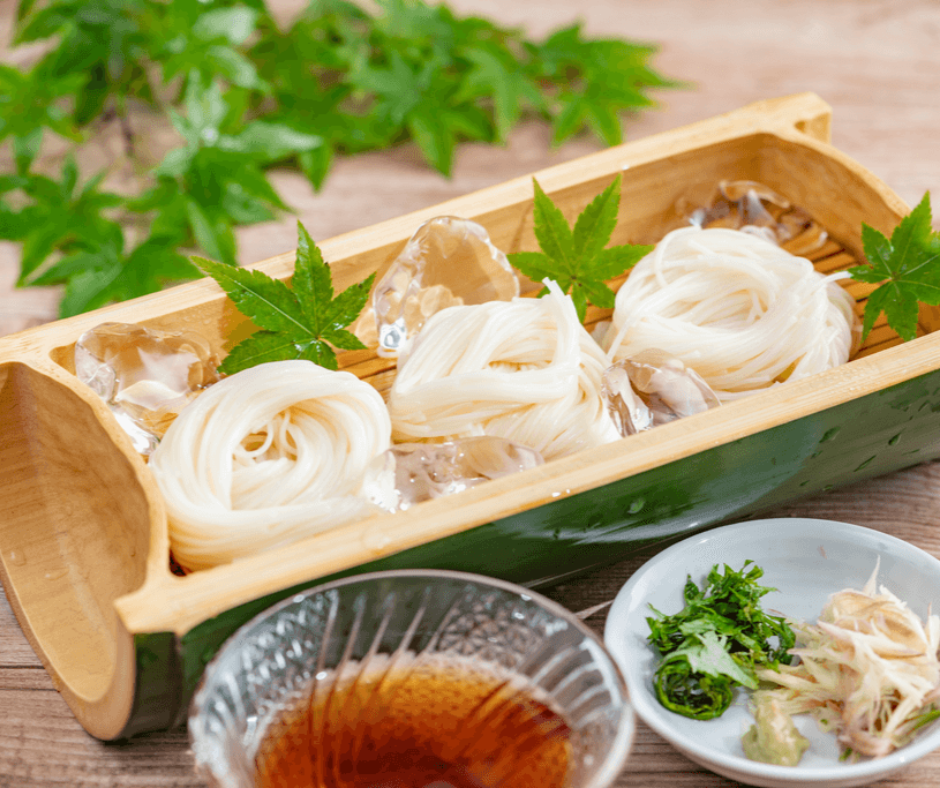Introduction
Japanese cuisine is beloved worldwide for its unique flavors and diverse ingredients. One of the most popular and versatile dishes in Japanese cuisine is noodles. From hearty bowls of ramen to light and delicate somen, there is a wide variety of Japanese noodles to explore and enjoy. But how can you compare Somen vs Ramen?
The Popularity Of Japanese Noodles And Their Cultural Significance
Japanese noodles have gained international acclaim and have become a staple in many countries due to their delicious taste and cultural significance. Noodles in Japanese cuisine are enjoyed in various forms, from soups to stir-fries, and are often the dish’s star. They are a delicious, satisfying meal and an important part of Japanese culture.
Japanese noodles use different ingredients and techniques, varying textures and flavors. Two popular types of Japanese noodles are somen and ramen. While both are delicious and widely enjoyed, the two have key differences.
Key Differences Between Somen And Ramen Noodles
- Ingredients: Somen noodles are made from wheat flour and are very thin, resembling angel hair pasta. They have a light and delicate texture, ideal for cold summer dishes. On the other hand, ramen noodles are made from wheat flour and kansui, an alkaline mineral water. They have a chewy texture and are typically used in hot noodle soups.
- Preparation: Somen noodles are often served cold and are typically dipped in a soy-based sauce or broth. They are commonly garnished with thinly sliced cucumbers, green onions, and grated ginger for added flavor. On the other hand, Ramen noodles are served hot in a flavorful broth and topped with various ingredients such as chashu (braised pork), vegetables, and a soft-boiled egg.
- Seasoning: Somen noodles have a delicate flavor and are typically enjoyed with a light dipping sauce or broth that enhances their natural taste. On the other hand, ramen noodles are often served in a rich and flavorful broth made from pork, chicken, or seafood, which adds depth and complexity to the dish.
- Regional Variations: While somen is enjoyed throughout Japan, it is particularly popular in Nagata. On the other hand, ramen has become a national obsession and is known for its numerous regional variations, each with unique broth and toppings.
In conclusion, both somen and ramen noodles are delicious and have their distinct characteristics. Whether you prefer the light and delicate flavors of somen or the rich and savory taste of ramen, exploring the world of Japanese noodles is a culinary adventure that will satisfy your cravings. So grab your chopsticks and start exploring the delicious world of Japanese noodles!
Somen Noodles
When it comes to Japanese noodles, most people are familiar with ramen. However, somen is another delicious and versatile noodle variety worth exploring. Somen noodles are thin, wheat-based, and typically served chilled, making them a perfect choice for hot summer days or as a refreshing appetizer.
Description And Characteristics Of Somen Noodles
Somen noodles are incredibly thin, often described as thin as human hair. These delicate noodles have a smooth and slippery texture, allowing them to absorb the flavors of the accompanying sauce or broth easily. They are usually made from wheat flour, salt, and water, which gives them a light and springy texture.
Varieties Of Somen Noodles And Their Significance
Several somen noodles are available, each with its unique qualities. Here are a few popular variations:
- Hiryori Somen: These noodles are made from high-quality wheat flour and are known for their exceptional smoothness and elasticity. Hiryori somen pairs well with dipping sauces and is commonly enjoyed during summer festivals.
- Hakata Somen: Originating from the Hakata region of Japan, these somen noodles have a slightly firmer texture than other varieties. They are often served hot and are favored for their ability to hold up well in rich, flavorful broths.
- Hiyamugi: Hiyamugi is a thinner version of somen noodles commonly used in soups and salads. These delicate noodles cook quickly and are perfect for lighter, refreshing meals.
Cooking Methods And Serving Styles
Somen noodles can be enjoyed hot and cold, depending on personal preference and the prepared dish. Here are a few popular cooking methods and serving styles:
- Chilled Somen: Chilled somen is a popular summer dish in Japan. The noodles are boiled until they reach the desired texture, then immediately rinsed in cold water to stop the cooking process. They are served on a bamboo mat with a dipping sauce and garnished with toppings like green onions, grated ginger, and nori seaweed.
- Hot Somen: Hot somen is typically enjoyed during colder months. The noodles are boiled and added to a flavorful broth, along with green onions, tofu, and tempura. This comforting dish is perfect for warming up on chilly days.
- Somen Salad: Somen noodles can also be used in salads. After cooking and cooling the noodles, they are tossed with fresh vegetables, protein (such as grilled chicken or shrimp), and a tangy dressing. This light and refreshing salad is perfect for a quick and healthy meal.
In conclusion, somen noodles are a great choice if you want to explore the world of Japanese noodles beyond ramen. With their delicate texture and versatility, they can be enjoyed in various dishes and are a delightful addition to any culinary adventure.
Somen Vs Ramen: Navigating Japanese Noodle Varieties
Whether you’re a food enthusiast or just love trying new flavors, navigating the world of Japanese noodles can be an exciting and delicious adventure. Somen and Ramen are two popular noodle varieties many love, but each has unique characteristics and flavors. Let’s examine Somen vs Ramen and what sets them apart.
Overview Of Ramen Noodles And Their Origins
Ramen is undoubtedly one of Japan’s most iconic dishes. It originated in China but has since become a staple in Japanese cuisine. Ramen noodles are made from wheat flour, salt, and water, creating a chewy and springy texture. They are typically served in a flavorful broth and topped with various ingredients such as sliced pork, green onions, seaweed, and a soft-boiled egg.
Different Types Of Ramen Noodles And Their Regional Variations
One of the great things about Ramen is the wide variety of regional styles available. Some of the most popular types include:
- Shoyu Ramen: This soy sauce-based broth is savory and deeply flavorful. It is often topped with chashu (braised pork belly), bamboo shoots, and nori (seaweed).
- Tonkotsu Ramen: Originating from Kyushu, this rich and creamy pork bone broth is a favorite among Ramen lovers. It is typically topped with thinly sliced pork, soft-boiled egg, and black garlic oil.
- Miso Ramen: Hailing from Hokkaido, this hearty Ramen features a broth made from fermented soybean paste. It offers a unique umami flavor and is often garnished with corn and butter.
Broth Options And Flavor Profiles
The broth is a crucial component of Ramen, as it contributes to the overall flavor profile of the dish. While the broth can vary depending on the regional style, it generally falls into four categories:
- Shoyu: This broth is made from soy sauce and has a salty and slightly sweet flavor.
- Tonkotsu: Known for its creamy and rich flavor, this broth simmers pork bones for several hours.
- Miso: The miso-based broth offers a savory and slightly sweet taste, adding depth to the Ramen.
- Shio: This clear broth is made with salt, producing a light and delicate flavor that allows the other ingredients to shine.
Whether you prefer the robust flavors of Tonkotsu Ramen or the subtle elegance of Somen noodles, exploring the world of Japanese noodles is a culinary adventure that will surely delight your taste buds. So grab your chopsticks, slurp away, and savor each delicious bite!
Somen Vs Ramen: A Comparison
Texture, Thickness, And Appearance Of Somen And Ramen Noodles
When comparing Somen vs Ramen, they have distinct texture, thickness, and appearance differences.
Somen noodles are slender, thin, and delicate. They have a smooth and chewy texture, similar to angel hair pasta. Somen noodles are served coldly, perfect for summer meals or refreshing salads. The noodles are often served in a light soy-based broth or dipping sauce, accompanied by various toppings such as sliced cucumber, scallions, and sesame seeds. Somen noodles’ white and translucent appearance adds to their elegant and light appeal.
Ramen noodles, on the other hand, are thicker and chewier. They have a springy texture that adds a satisfying bite to each slurp. Ramen noodles are served hot in a flavorful broth made from pork, chicken, or vegetable stock. The noodles can be curly or straight, and their appearance varies depending on the region and style of Ramen. Traditional Ramen toppings include sliced pork, soft-boiled eggs, seaweed, and green onions. The dish is known for its richness and depth of flavors.
Contrasting Flavors And Toppings
Somen and Ramen also differ in terms of flavors and toppings.
Somen noodles are often paired with light and refreshing flavors. The dipping sauce or broth used in Somen dishes is usually soy-based, offering a delicate umami taste. Toppings such as cucumber, scallions, and sesame seeds further enhance the overall freshness and mildness of Somen.
Ramen, on the other hand, presents a wide range of bold and robust flavors. The broth can be soy-based, miso-based, or even infused with seafood flavors. The toppings in Ramen are more varied and indulgent, with options like fatty pork slices, marinated bamboo shoots, and nori seaweed. Each region in Japan has its unique style and flavor profile of Ramen, making it a versatile and exciting dish.
Traditional Serving Styles And Cultural Significance
Somen and Ramen also have different serving styles and cultural significance.
Somen is often enjoyed during the hot summer months in Japan. It is commonly served as a light and refreshing meal or as a part of celebratory occasions such as festivals. The delicate and elegant nature of Somen reflects the simplicity and grace of Japanese cuisine.
On the other hand, Ramen has gained worldwide popularity and is often viewed as a comforting and satisfying meal. Ramen shops in almost every corner of Japan offer different regional styles and variations. Ramen has become a symbol of Japanese fast food and is widely appreciated for its rich flavors and hearty servings.
In conclusion, both Somen and Ramen are beloved Japanese noodle dishes, but they differ in various aspects such as texture, flavors, toppings, serving styles, and cultural significance. Whether you prefer the light and delicate Somen or Ramen’s bold and robust flavors, both noodles will surely provide a delicious and satisfying dining experience.
Choosing The Right Noodle
When it comes to Japanese noodles, there are numerous varieties to choose from. Two popular options are somen and ramen. If you’re trying to decide between the two, a few factors can help you make the right choice for your taste preferences and the dish you’re planning to create.
Factors To Consider When Selecting Between Somen And Ramen
Texture: Somen is known for its thin and delicate texture, while ramen has a thicker and chewier texture. If you prefer a lighter and smoother noodle, somen might be the way. On the other hand, if you enjoy a heartier and more substantial bite, ramen is the better option.
Broth: One key difference between somen and ramen is how they are typically served. Somen is often enjoyed in a cold dipping sauce, while ramen is commonly served in a flavorful broth. If you’re craving a refreshing and light dish, somen is a great choice with its cold sauce. Ramen’s rich broth is the way for a warm and comforting meal.
Toppings: Somen and ramen can be topped with various ingredients, but some toppings are more commonly associated with each noodle. Somen is often garnished with light and fresh toppings like green onions, seaweed, and thinly sliced meats. On the other hand, Ramen can be topped with a wide range of ingredients such as pork belly, soft-boiled eggs, bamboo shoots, and nori.
Personal Preferences And Taste Preferences
Ultimately, the choice between somen and ramen comes down to personal preference. Some people prefer the simplicity and subtlety of somen, while others enjoy ramen’s complexity and bold flavors. It’s worth experimenting with both noodles to see which aligns better with your taste preferences.
Pairing Noodles With Different Dishes
Consider the dish you plan to create when deciding between somen and ramen. Somen’s delicate texture and light flavor make it a great match for salads, stir-fries, and cold noodle dishes. Ramen’s heartier texture and robust flavors make it perfect for rich and savory dishes like ramen bowls, stir-fried noodles, and noodle soups.
Ultimately, somen and ramen have unique qualities that make them wonderful choices for different occasions. Whether you prefer a light and refreshing noodle or a hearty and flavorful one, the versatility of Japanese noodles ensures that there’s always a perfect option available.
Conclusion
Now you should know how to compare Somen vs Ramen. They are delicious Japanese noodle varieties offering unique taste experiences. Somen noodles are thin, delicate, and perfect for cold dishes or a simple, light meal. They are typically served with a dipping sauce and are popular during the hot summer. On the other hand, Ramen noodles are thick, chewy, and often served in a flavorful broth with various toppings. They are a hearty and satisfying meal that can be enjoyed year-round.
Summary Of The Main Differences And Characteristics Of Somen And Ramen Noodles
Somen noodles are thin and delicate, while Ramen noodles are thick and chewy. Somen is typically served cold with a dipping sauce, while Ramen is served in a hot broth with toppings. Somen is ideal for light, refreshing meals, while Ramen is more substantial and filling.
Exploring The Versatility And Enjoyment Of Japanese Noodle Varieties
Japanese noodle varieties, such as Somen and Ramen, offer various flavors and textures. They can be enjoyed in various preparations, from simple and light to rich and hearty. Whether you prefer a cold, refreshing Somen dish or a warm, comforting bowl of Ramen, these noodles will satisfy your cravings.
Additionally, the versatility of these noodles allows for creative experimentation with different ingredients and flavors. You can customize your Somen or Ramen with various toppings such as sliced meats, vegetables, eggs, or nori seaweed. The endless possibilities make Japanese noodle dishes a fun culinary adventure.
So, whether you’re in the mood for a light, refreshing meal or a hearty and satisfying bowl, explore the world of Somen and Ramen noodles. These delicious Japanese noodle varieties glimpse Japan’s rich and diverse culinary traditions.
FAQ: Somen vs Ramen: Navigating Japanese Noodle Varieties
Q: What are the main differences between somen and ramen?
A: Somen and ramen are both types of Japanese noodles, but they have distinct differences. Somen is typically enjoyed cold with a dipping sauce, while ramen is served in a flavorful broth with various toppings.
Q: Can somen be served with a hot soup or broth?
A: Yes, although somen is primarily enjoyed cold, it can also be served with a hot soup or broth. However, the traditional way to enjoy somen is to have it cold with a dipping sauce made from soy sauce, dashi, and mirin.
Q: What are the toppings commonly used with somen?
A: Somen can be served with a variety of toppings to enhance its flavor. Thinly sliced cucumber, grated ginger, and chopped scallions are some of the popular choices. These toppings add a refreshing and light element to the dish.
Q: Is somen more popular during hot weather in Japan?
A: Yes, somen is a highly popular choice in Japan during hot weather. Its refreshing and light flavor makes it an ideal option to combat the heat. Many people enjoy somen as a cooling snack or as a light and refreshing meal.
Q: What is the significance of ramen in Japan?
A: Ramen is one of the most well-known and beloved types of Japanese noodles not only in Japan but also worldwide. It is typically served in a flavorful broth with various toppings, such as sliced pork, boiled egg, bamboo shoots, and scallions. Ramen has become a staple dish in Japanese cuisine.
Q: How are Japanese noodles different from noodles in other cuisines?
A: Japanese noodles can best be described as a food category rather than a specific dish. While the world may be familiar with certain types like ramen and udon, Japan offers an incredible variety of noodle types with distinct tastes and preparation methods. It is important to be specific when ordering noodles at a restaurant, just as one would specify the type of soup or salad desired.



